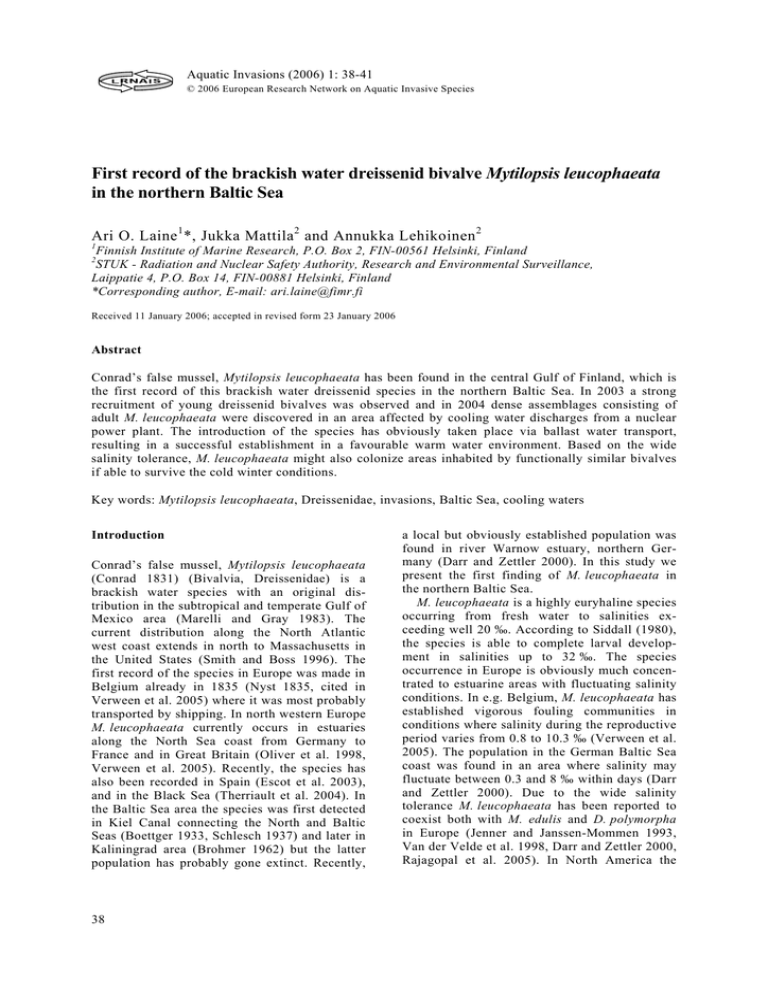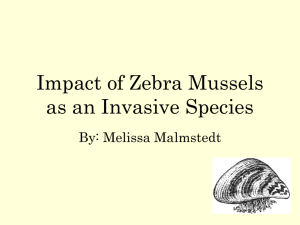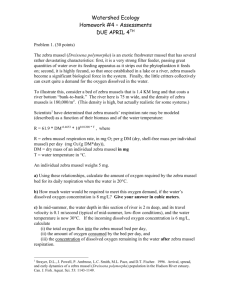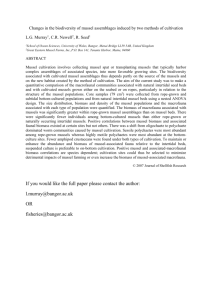Mytilopsis leucophaeata in the northern Baltic Sea Ari O. Laine *, Jukka Mattila
advertisement

Aquatic Invasions (2006) 1: 38-41 © 2006 European Research Network on Aquatic Invasive Species First record of the brackish water dreissenid bivalve Mytilopsis leucophaeata in the northern Baltic Sea Ari O. Laine 1 *, Jukka Mattila 2 and Annukka Lehikoinen 2 1 Finnish Institute of Marine Research, P.O. Box 2, FIN-00561 Helsinki, Finland STUK - Radiation and Nuclear Safety Authority, Research and Environmental Surveillance, Laippatie 4, P.O. Box 14, FIN-00881 Helsinki, Finland *Corresponding author, E-mail: ari.laine@fimr.fi 2 Received 11 January 2006; accepted in revised form 23 January 2006 Abstract Conrad’s false mussel, Mytilopsis leucophaeata has been found in the central Gulf of Finland, which is the first record of this brackish water dreissenid species in the northern Baltic Sea. In 2003 a strong recruitment of young dreissenid bivalves was observed and in 2004 dense assemblages consisting of adult M. leucophaeata were discovered in an area affected by cooling water discharges from a nuclear power plant. The introduction of the species has obviously taken place via ballast water transport, resulting in a successful establishment in a favourable warm water environment. Based on the wide salinity tolerance, M. leucophaeata might also colonize areas inhabited by functionally similar bivalves if able to survive the cold winter conditions. Key words: Mytilopsis leucophaeata, Dreissenidae, invasions, Baltic Sea, cooling waters Introduction Conrad’s false mussel, Mytilopsis leucophaeata (Conrad 1831) (Bivalvia, Dreissenidae) is a brackish water species with an original distribution in the subtropical and temperate Gulf of Mexico area (Marelli and Gray 1983). The current distribution along the North Atlantic west coast extends in north to Massachusetts in the United States (Smith and Boss 1996). The first record of the species in Europe was made in Belgium already in 1835 (Nyst 1835, cited in Verween et al. 2005) where it was most probably transported by shipping. In north western Europe M. leucophaeata currently occurs in estuaries along the North Sea coast from Germany to France and in Great Britain (Oliver et al. 1998, Verween et al. 2005). Recently, the species has also been recorded in Spain (Escot et al. 2003), and in the Black Sea (Therriault et al. 2004). In the Baltic Sea area the species was first detected in Kiel Canal connecting the North and Baltic Seas (Boettger 1933, Schlesch 1937) and later in Kaliningrad area (Brohmer 1962) but the latter population has probably gone extinct. Recently, 38 a local but obviously established population was found in river Warnow estuary, northern Germany (Darr and Zettler 2000). In this study we present the first finding of M. leucophaeata in the northern Baltic Sea. M. leucophaeata is a highly euryhaline species occurring from fresh water to salinities exceeding well 20 ‰. According to Siddall (1980), the species is able to complete larval development in salinities up to 32 ‰. The species occurrence in Europe is obviously much concentrated to estuarine areas with fluctuating salinity conditions. In e.g. Belgium, M. leucophaeata has established vigorous fouling communities in conditions where salinity during the reproductive period varies from 0.8 to 10.3 ‰ (Verween et al. 2005). The population in the German Baltic Sea coast was found in an area where salinity may fluctuate between 0.3 and 8 ‰ within days (Darr and Zettler 2000). Due to the wide salinity tolerance M. leucophaeata has been reported to coexist both with M. edulis and D. polymorpha in Europe (Jenner and Janssen-Mommen 1993, Van der Velde et al. 1998, Darr and Zettler 2000, Rajagopal et al. 2005). In North America the A . L a i n e e t a l . , M y t i l o p s i s l e u c o p h a e a ta i n t h e B a l t i c S e a distribution of M. leucophaeata and D. polymorpha overlap especially in salinities below 3.0 ‰ (Pathy and Mackie 1993). In western Europe M. leucophaeata has become a serious biofouling organism in cooling water systems with economical impacts for water dependent industries (Jenner and Janssen-Mommen 1993, Verween et al. 2005). The species is obviously more tolerant to common control methods (e.g. chlorination and heat treatment) than the zebra mussel, Dreissena polymorpha or the blue mussel, Mytilus edulis (Rajagopal et al. 2002, 2005). Observations in the Gulf of Finland In autumn 2003, a pronounced settlement of young dreissenid mussels was observed in Loviisa archipelago, northern coast of the central Gulf of Finland, leading to a dense adult population thereafter. The species was first identified as zebra mussel, Dreissena polymorpha, which had been recently increasing in numbers in the eastern Gulf of Finland (Antsulevich et al. 2003). However, an examination of adult mussels collected in December 2004 at the island of Hästholmen, Loviisa (60°22.1’ N, 26°21.3’ E) revealed the species to be the very similar looking Conrad’s false mussel, Mytilopsis leucophaeata (Conrad 1831). The species has not been previously observed in the northern Baltic Sea. The identification of mussels was based on characteristics presented in Marelli and Gray (1983). In general, M. leucophaeata resembles much D. polymorpha and especially young individuals are difficult to distinguish. Adult individuals found are usually brownish in colour without the stripe patterns that are typical to young individuals. The shell shape of M. leucophaeata is less angular than in D. polymorpha and resembles more the form of M. edulis. M. leucophaeata shells do not have a longitudinal ridge typical to D. polymorpha (Figure 1). However, the exact species identification of M. leucophaeata is based on an internal shell structure. Both D. polymorpha and M. leucophaeata have in the anterior end a myophore plate used for muscle attachment but in M. leucophaeata there is also dorso-laterally closely attached a tooth-like projection, an apophysis (Figure 2), which is absent in D. polymorpha. Microscopic examination of this structure is needed for species identification. Figure 1. Shells of Conrad’s false mussel, Mytilopsis leucophaeata. The length of the largest individual is about 20 mm. The young individuals have typical stripe patterns that resemble much zebra mussel, Dreissena polymorpha. The adult individuals are usually even brownish in colour and the shell shape is less angular than in D. polymorpha. Figure 2. Conrad’s false mussel, Mytilopsis leucophaeata with opened shells. The arrows point the tooth-like projection, apophysis, in the anterior end of the animal. The occurrence of M. leucophaeata in the Gulf of Finland has been confirmed so far in the sea area from Loviisa to archipelago of Pernaja. The densest assemblages of M. leucophaeata found since 2003 are clearly located in a coastal semienclosed bight that is directly affected by the cooling waters of the Loviisa nuclear power plant. Near the power plant the seawater surface salinity is about 4.3 ‰ and during summer the water temperature may exceed 25°C. In winter the water temperature is about 5°C keeping this area ice free in contrast to typical winter conditions in the Gulf of Finland. The mussel assemblages, observed by scuba diving and sam 39 A . L a i n e e t a l . , M y t i l o p s i s l e u c o p h a e a ta i n t h e B a l t i c S e a pling, covered stones and boulders up to 100 % and were mainly found in the depth of 1-3 m. In these populations densities and biomass up to 28 000 individuals/m2 and 9.8 kg/m2 (wet weight), respectively, were observed. These numbers are clearly higher than those found in the southern Baltic Sea (50 ind./m2; Darr and Zettler 2000). In Loviisa, high numbers of M. leucophaeata were also found attached on the macroalgae Fucus vesiculosus. The maximum length of mussels sampled in December 2004 was 21 mm and most of the individuals were larger than 10 mm. M. leucophaeata may reach a maximum size of about 22 to 25 mm in length (Siddall 1980, Pathy and Mackie 1993). Based on measurements of individuals from the 2005 recruitment the growth rate of M. leucophaeata may be high. A maximum length of 17 mm was recorded for first-year mussels in the end of the growing season. Discussion Due to the long distance to the nearest abundant M. leucophaeata populations in the North Sea area and local populations in the southern Baltic Sea, it is obvious that M. leucophaeata has been transported to the Gulf of Finland as larvae in ships ballast water as spread by natural means is unlikely over such long distances. The first findings were located only a couple of kilometres from the port of Loviisa. The cooling water discharge area has obviously offered a favourable environment for survival and reproduction of the species and can act as a bridgehead for further spread of the species. The present findings also demonstrate that cooling water areas are potential hot spots for introduction of alien species originating from warm waters, as predicted by Gollasch and Leppäkoski (1999). The current occurrence of M. leucophaeata is located at the high-salinity tolerance limit of D. polymorpha and low-salinity tolerance of M. edulis. Thus it seems that M. leucophaeata has found an open ecological niche in the area as a hard bottom filter-feeding bivalve. Due to the wide salinity tolerance, M. leucophaeata would be able to widen its distribution, which could lead to resource competition with two other mussel species in the Gulf of Finland. Based on settlement studies with artificial plates in 2004-2005 a wider distribution of young, first-year M. leucophaeata has been observed. After the successful reproduction in 2005, mussels were also found 40 on natural substrates of rocks and stones in the sea area of Pernaja about 15 km southwest from Loviisa. Future studies will show if M. leucophaeata is able to establish adult populations also in this area, which is not affected by the cooling water discharges. Based on its original distribution M. leucophaeata is considered a warm water species able to live in temperate areas also (Marelli and Gray 1983). It is however possible that the majority of the mussels do not survive harsh winter conditions since the distribution of old individuals found in this study seems to be much restricted to the area affected by warm cooling waters from the power plant. Temperature affect e.g. reproduction and according to Verween et al. (2005) the gamete maturation starts at about 13°C, which is slightly higher than for D. polymorpha. The lower temperature limit for the survival of juvenile and adult M. leucophaeata is not known. This factor might limit the establishment of permanent populations in a highly seasonal environment where winter temperatures fall close to 0°C, as in the northern Baltic Sea. However, more field investigations are needed to verify the current distribution of M. leucophaeata and its dependence on warm water discharges. Also, special attention should be paid on species identification of especially young dreissenid mussels to reveal the large-scale distribution of M. leucophaeata in the Baltic Sea. Acknowledgements S. Rajagopal (University of Nijmegen, The Netherlands) and A. Verween (University of Gent, Belgium) are kindly acknowledged for help with species identification. We are also grateful to K. Huusela (STUK, Finland) for his involvement in the studies. References Antsulevitch AE, Välipakka P and Valovirta I (2003) How are the zebra mussels doing in the Gulf of Finland? Proceedings of the Estonian Academy of Sciences 52: 268-283 Boettger CR (1933) Über die Ausbreitung der Muschel Congeria cochleata Nyst in europäischen Gewässern und ihr Auftreten im Nordostseekanal. Zoologischer Anzeiger 101: 43-48 Brohmer P (1962) Die Weichtiere Mitteleuropas. In: Die Tierwelt Mitteleuropas, Band 2, 1. Ergänzung. Quelle & Meyer, Leipzig Darr A and Zettler ML (2000) Erstnachweis von Congeria leucophaeata (Conrad, 1831) in Mecklenburg-Vorpommern (Bivalvia: Dreissenidae). Malakologische Abhandlungen 20: 197-200 A . L a i n e e t a l . , M y t i l o p s i s l e u c o p h a e a ta i n t h e B a l t i c S e a Escot C, Basanta A, Cobo F and Gonzalez MA (2003) Sobre la presencia de Mytilopsis leucophaeata (Conrad, 1831) (Bivalvia, Dreissenacea, Dreissenidae) en el rio Guadalquivir (sur de la Peninsula Iberica). Graelisia 59: 91-94 Gollasch S and Leppakoski E (1999) Initial Risk Assessment of Alien Species in Nordic Coastal Waters. Nord 1999:8. Nordic Council of Ministers, Copenhagen, 244 pp Jenner HA and Janssen-Mommen JPM (1993) Monitoring and control of Dreissena polymorpha and other macrofouling bivalves in the Netherlands. In: Nalepa TF and Schloesser DW (eds) Zebra mussels: Biology, impacts, and control, Lewis Publishers, Boca Raton, FL, pp 537-554 Marelli DC and Gray S (1983) Conchological redescriptions of Mytilopsis sallei and Mytilopsis leucophaeata of the brackish Western Atlantic (Bivalvia: Dreissenidae). Veliger 25: 185-193 Oliver PG, Holmes AM and Mettam C (1998) Mytilopsis leucophaeata, (Conrad 1831) (Bivalvia: Dreissenoidea). A species new to the British fauna. Journal of Conchology 36: 13-18 Pathy DA and Mackie GL (1993) Comparative shell morphology of Dreissena polymorpha, Mytilopsis leucophaeata, and the “quagga” mussel (Bivalvia, Dreissenidae) in North America. Canadian Journal of Zoology 71:1012-1023 Rajagopal S, Van der Gaag M, Van der Velde G and Jenner HA (2002) Control of brackish water fouling mussel, Mytilopsis leucophaeata (Conrad) with sodium hypochlorite. Archives of Environmental Contamination and Toxicology 43: 296–300 Rajagopal S, Van der Gaag M, Van der Velde G and Jenner HA (2005) Upper temperature tolerances of exotic brackish-water mussel, Mytilopsis leucophaeata (Conrad): An experimental study. Marine Environmental Research 60: 512-530 Schlesch H (1937) Bemerkungen über die Verbreitung der Süsswasser- und Meeresmollusken im östlichen Ostseegebiete. Tartu Loodusuurijate Seltsi Aruanded 43: 37-64 Siddall SE (1980) Early development of Mytilopsis leucophaeata (Bivalvia, Dreissenacea). Veliger 22: 378-379 Smith DG and Boss KJ (1996) The occurrence of Mytilopsis leucophaeata (Conrad, 1831) (Veneroida, Dreissenidae) in Southern New England. Veliger 39: 259-360 Therriault TW, Docker MF, Orlova MI, Heath DD, MacIsaac HJ (2004). Molecular resolution of the family Dreissenidae (Mollusca: Bivalvia) with emphasis on Ponto-Caspian species, including first report of Mytilopsis leucophaeata in the Black Sea basin. Molecular Phylogenetics and Evolution 30: 479-489 Van der Velde G, Van der Gaag R, Rajagopal S, Jenner HA (1998) Where Exotic Mussels Dreissena polymorpha and Mytilopsis leucophaeata Meet in the Brackish Noordzeekanaal, the Netherlands. Abstracts from the Eighth International Zebra Mussel and Other Nuisance Species Conference, Sacramento California March 16-19, 1998 Verween A, Vincx M, Mees J and Degraer S (2005) Seasonal variability of Mytilopsis leucophaeata larvae in the harbour of Antwerp: implications for ecologically and economically sound biofouling control. Belgian Journal of Zoology 135: 91-93 41





